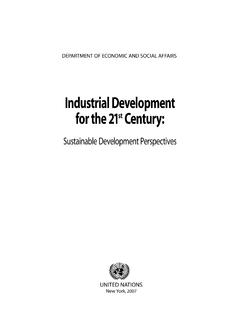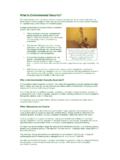Transcription of Programme on Innovation, Higher Education and …
1 1 2 Programme on innovation , Higher Education and research for Development IHERD This report is authored by James Otieno Jowi, Milton Obamba, Chika Sehoole, Goski Alabi, Ogachi Oanda and Maria Barifaijo as part of the Programme on innovation , Higher Education and research for Development (IHERD) hosted at the OECD and funded by the Swedish International Development Cooperation Agency (Sida). The opinions expressed and arguments employed herein are those of the author and do not necessarily reflect the official views of the OECD or Sida or of the governments of the OECD member countries 3 Acknowledgements This work is a result of the efforts by several people who had to put aside their busy schedules to meet the demands of the short time of this project. I would like to sincerely appreciate the leading roles that Prof.
2 Chika Sehoole, Prof. Goski Alabi, Dr. Maria Barifaijo, Mulumba, Obamba and Dr. Ibrahim Oanda put in coming up with the different sections of this document. Special thanks to Ms. Christiana Badoo for the information she provided in the compilation of the Ghana chapter. In the same vein we thank Omoso for his usefulness in gathering information for the study. We are also indebted to any other persons and offices that contributed towards making this work a success. All this would not have been possible without the logistical support of the staff in ANIE office. Lastly, I would like to appreciate OECD for providing us with funding for this project. In this regard I want to sincerely thank Asa Olsson for all the support she gave. James Otieno Jowi Executive Director, ANIE 4 Table of Contents Executive summary.
3 5 Chapter 1 .. 6 Overview of Higher Education in Africa Introduction .. 8 Chapter 2 .. 11 Internationalisation, research , Innovations and Management in Africas Higher Education : An Overview Introduction .. 11 Higher Education in Africa: An overview .. 12 Knowledge deficits and research capacity gaps in African 17 Science, technology and innovation .. 18 Partnerships for knowledge and development .. 24 The changing landscape of Africa s knowledge 25 Opportunities from internationalisation .. 34 Conclusions .. 36 Chapter 3 .. 40 Case study of Ghana Introduction .. 40 Overview of the Economy of Ghana .. 41 The Higher Education system in Ghana .. 43 research , knowledge production and innovation in Ghana .. 47 Role of Universities and research Institutes in innovation and National Development .. 54 Promoting research and innovation in Ghanaian Universities .. 55 The role of internationalisation.
4 59 Future of research and innovation in Ghana Index .. 62 Chapter 4 .. 67 Case study of Kenya Introduction .. 67 Trends and changes in policy and the roles of the university .. 68 The impacts of internationalisation .. 98 5 National Policy 100 Institutional implications of internationalisation .. 103 Conclusion .. 107 Chapter 5 .. 112 Case study of Uganda Background to Higher Education in Uganda .. 112 Higher Education governance and policy .. 119 Policy framework for research and knowledge creation .. 120 Institutional environment for research and innovation .. 125 University linkages with business/ industries .. 127 Internationalisation and Higher Education in Uganda .. 128 Conclusion .. 129 6 Executive summary The OECD has carried out a study on Governance of Higher Education , research and innovation in Ghana, Kenya and Uganda as a part of the OECD Programme on Higher Education and research for Development (IHERD), which is financed by the Swedish International Development Cooperation Agency.
5 The report consists of an overview of the Higher Education landscape in Africa and three case studies on Ghana, Kenya and Uganda. The case studies of Ghana, Kenya and Uganda show that: Recent development policy frameworks and program initiatives in the three countries demonstrate a clear focus on the interconnectedness between STI (science technology, and innovation ) and development planning. However, the level of coherence within and among the existing policies, programs, and institutions still remains relatively weak. Policymakers require greater awareness and capacity building to ensure that national STI policies and programs capture the national development priorities and are internally and externally consistent in order to promote policy complementarily, coherence, and effectiveness. Notwithstanding the increasing mainstreaming of STI at the national development policy level, and despite the growing emphasis on the instrumentality of universities in promoting economic competitiveness and sustainable development, Higher Education institutions across the three countries remain poorly integrated into the emerging knowledge-based development paradigm and discourse.
6 Higher Education institutions still lack the required vision, resources, capacity, and leadership to embrace science technology and innovation as a guiding principle for their strategic planning and academic programs. The disjoint between national-level policies and institutional realities represent a devastating challenge to the realisation of knowledge-based economies in African countries. Senior leadership within universities and research institutions therefore require skills and capacity strengthening to be able to embed knowledge, enterprise, and innovation into their own strategic plans and research programs in order to discharge their mandate as catalysts of development; The three countries demonstrate impressive but varying levels of sophistication with respect to recent policy frameworks and governance arrangements for the management of their national research and innovation systems.
7 Ghana and Kenya represent more elaborate and dynamic governance landscapes than Uganda; but all three countries clearly demonstrate an unmistakeable emphasis on developing more effective national institutional arrangements and policies to promote research governance and nurture knowledge economies. The key and most persistent weakness is the lack of national and institutional policies and programs that stimulate collaboration and knowledge exchange between research subsystems and the industrial and business subsystems. Inadequate and undiversified funding regimes remain a major challenge to the development of more vibrant research and innovation infrastructure in the three countries and across the sub-Saharan region. In the absence of private-sector funding and competitive grants, public 7 universities and research institutes in the Sub-Saharan region predominantly depend on dwindling public subsidies as well as unpredictable international donor support.
8 This narrow funding base suggests that research and innovation systems in the three countries face severe financial deficits and lack the capacity to formulate and drive their own domestic research agendas. National policymakers and university leadership need to be encouraged to work in closer partnership and to prioritize the strategic importance of research and innovation in national economic growth and competitiveness by investing more significantly in strengthening research capacity, infrastructure, and research opportunities in universities. The three country case studies demonstrate that internationalisation, particularly through transnational and transdisciplinary partnerships among universities; represent one of the most effective options for strengthening research capacity and governance arrangements for research and innovation in sub-Saharan countries.
9 The studies demonstrate the need for systematic and coherent approaches to integrating STI Policy into national economic and development strategy. This embedding process should accord particular emphasis on the coherent translation and cascading of national development goals and STI policies into clear action plans and intervention programs that are directly connected to promoting economic growth and improving people s real livelihoods. 8 Chapter 1 James Otieno Jowi, African Network for Internationalisation of Education (ANIE) Overview of Higher Education in Africa Introduction Universities in Africa have always been thought of in terms of their role in development. The idea of development universities (Cloete et. al., 2011) underlined the role of universities in development to meet the human resource needs of the economy.
10 According to Varghese (2013) the state and public sector institutions were central to the development strategy of the newly independent countries in Africa. This model was replicated in Education . Higher Education was provided through public universities. The decades of 1960s and 1970s saw the establishment of new universities in African countries. Further, public universities in these countries also symbolized national pride and self-respect (Coleman and Court, 1993) and self reliance. Under this frame of analysis, the expansion of Higher Education served both political and economic aspirations of the newly independent governments. Hence, the governments were willing to allocate resources and invest in Higher Education . Despite the weakening of the sector in the 1980s as a result of redirection of resources away from universities to primary Education , the university sector managed to regain its central role in development at the dawn of the 21stcentury.

















